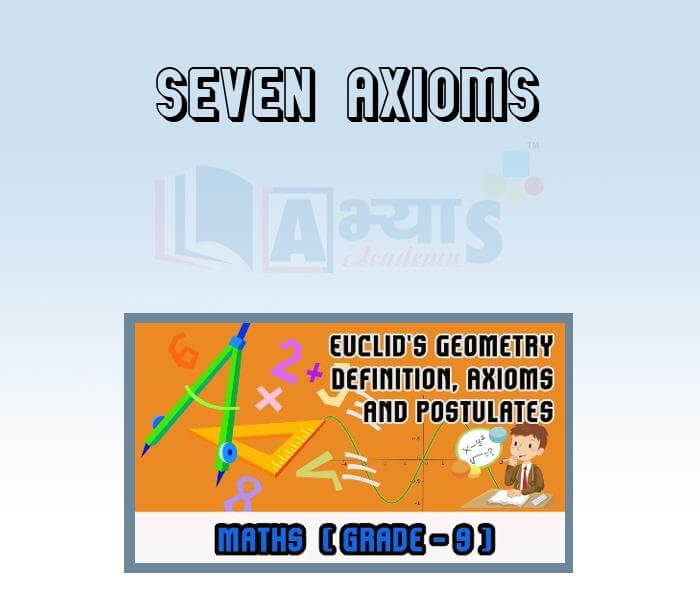Seven Axioms

Seven Axioms
Euclid seven axioms :
These 'common notions' refer to magnitidues of some kind. The first common notion could be applied to plane figures. For example, if an area of a triangle equals the area of a rectangle and the areas of the rectangle equals that of a square, then the area of the triangle also equal the area of the square.
Magnitudes of the same kind can be compared and added, but magnitudes of different kinds cannot be added to a rectangle, nor can angle be compared to a pentagon.
The 4th axiom given above seems to say that if two things are identical (that is, they are the same), then they are equal. In other words, everything equals itself. It is the justification of the principle of superposition. Axiom (5) gives us the definition of greater than. For example , if a quantity B is a part of another quantity A, then A can be written as the sum of B and so third quantity C. Symbolically, A>B means that there is some C such that A = B + C.
Example : Two district lines cannot have more than one point in common.
Proof: Here we are given two lines L and m. we need to prove that they have only one point in common.
For the time being, let us suppose that the two lines intersect in two distinct points, say P and Q. So, youhave two lines passing through two distinct points P and Q . But this assumption clashes with the axiom that only one line can pass throught two distinct. points. So, the assumption that we started with , that two lines can pass thorugh two distinct points is wrong.
From this, what can we conclude? We are forced to conclude that two distinct lines cannot have more than one point in common.
Students / Parents Reviews [10]
About Abhyas metholodology the teachers are very nice and hardworking toward students.The Centre Head Mrs Anu Sethi is also a brilliant teacher.Abhyas has taught me how to overcome problems and has always taken my doubts and suppoeted me.

Shreya Shrivastava
8thOne of the best institutes to develope a child interest in studies.Provides SST and English knowledge also unlike other institutes. Teachers are co operative and friendly online tests andPPT develope practical knowledge also.

Aman Kumar Shrivastava
10thMy experience was very good with Abhyas academy. I am studying here from 6th class and I am satisfied by its results in my life. I improved a lot here ahead of school syllabus.

Ayan Ghosh
8thAbhyas is a complete education Institute. Here extreme care is taken by teacher with the help of regular exam. Extra classes also conducted by the institute, if the student is weak.

Om Umang
10thI have spent a wonderful time in Abhyas academy. It has made my reasoning more apt, English more stronger and Maths an interesting subject for me. It has given me a habbit of self studying

Yatharthi Sharma
10thMy experience with Abhyas is very good. I have learnt many things here like vedic maths and reasoning also. Teachers here first take our doubts and then there are assignments to verify our weak points.

Shivam Rana
7thAbhyas Methodology is very good. It is based on according to student and each child manages accordingly to its properly. Methodology has improved the abilities of students to shine them in future.

Manish Kumar
10thIt was good as the experience because as we had come here we had been improved in a such envirnment created here.Extra is taught which is beneficial for future.

Eshan Arora
8thA marvelous experience with Abhyas. I am glad to share that my ward has achieved more than enough at the Ambala ABHYAS centre. Years have passed on and more and more he has gained. May the centre flourish and develop day by day by the grace of God.

Archit Segal
7thMy experience with Abhyas academy is very good. I did not think that my every subject coming here will be so strong. The main thing is that the online tests had made me learn here more things.




